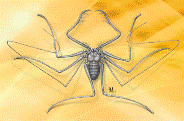Papers in the Biological Sciences

Eileen Hebets Publications
ORCID IDs
http://orcid.org/0000-0002-5826-467X Jacob M. Graving
Document Type
Article
Date of this Version
4-11-2017
Citation
Published in Journal of Comparative Physiology A 203 (2017), pp 313–328. DOI 10.1007/s00359-017-1169-5
Abstract
Amblypygids are capable of navigation in the complex terrain of rainforests in near complete darkness. Path integration is unnecessary for successful homing, and the alternative mechanisms by which they navigate have yet to be elucidated. Here, our aims were to determine whether the amblypygid Phrynus marginemaculatus could be trained to reliably return to a target shelter in a laboratory arena—indicating goal recognition—and to document changes in behavior associated with the development of fidelity. We recorded nocturnal movements and space use by individuals over five nights in an arena in which subjects were provided with two shelters that differed in quality. The target shelter, unlike the alternative shelter, shielded subjects from light in daylight hours. Individuals consistently exited and returned to a shelter each night and from the third night onward chose the target shelter more often than the alternative shelter. Indeed, on the fifth night, every subject chose the target shelter. This transition was associated with changes in movement and space use in the arena. Notably, the movement features of outbound and inbound paths differed but did not change across nights. Individuals were also characterized by distinct behavioral strategies reflecting candidate homing mechanisms.
Included in
Animal Sciences Commons, Behavior and Ethology Commons, Biology Commons, Entomology Commons, Genetics and Genomics Commons


Comments
Copyright © 2017 Springer-Verlag Berlin Heidelberg. Used by permission.